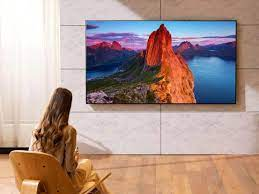Buying a new TV can be daunting with so many options available so we’ve outlined the four main things to look out for to find the perfect TV to meet your needs.
Screen technology
Screens currently come in four different formats: LED, NanoCell, OLED and QLED.
LED and NanoCell screens use light-emitting diodes to backlight the panel, with NanoCell seeing some vast improvements in display quality. LED is typically the cheapest option, the main pitfall being decreased viewing angles. This isn’t usually a huge problem if your screen is static and set up for your preferred viewing position.

QLED is very similar to NanoCell technology and both are an improvement over basic LED screens.
OLED is used in most premium devices. OLED doesn’t use a backlight and instead lights up individual pixels resulting in stunning detail and depth. The downfall of this technology is an increased risk of burn-in, which can be significantly delayed with careful screen management. Essentially, don’t leave a static image on screen for too long!
Resolution and Refresh rate
This identifies how many pixels the device can display. More pixels means more detail. The current options are Full HD, 4k and 8k. 4k has 4x the same number of pixels as Full HD and 8k has four times the number of pixels of 4k. This Samsung guide provides more details:
The refresh rate is shown in Hz or fps and a higher refresh rate is better. It’s not hugely important for watching videos but if you plan to game or watch live sports, this can drastically reduce screen lag and motion blur.
Connectivity, tuners, smart apps
It’s worth paying attention to the outputs. Most will come with HDMI but for gaming, you might appreciate HDMI 2.1. Some TVs come with older generation outputs for backwards compatibility. If you want to watch Freeview or Freesat without internet connectivity, look for a built-in TV tuner. You’ll also need a working aerial. Specialist firms such as this one for TV aerial repair Cheltenham can advise:steveunettaerials.co.uk/our-services/aerial-services/tv-aerial-repair/tv-aerial-repair-cheltenham Otherwise, check the availability of smart apps if you won’t use a separate device.

Sound
Most people prefer to use a separate sound system, but if you plan to run the default speakers, Dolby Atmos can drastically improve the sound quality. It’s the same technology used in cinemas and it’s present in televisions across the budget range.
